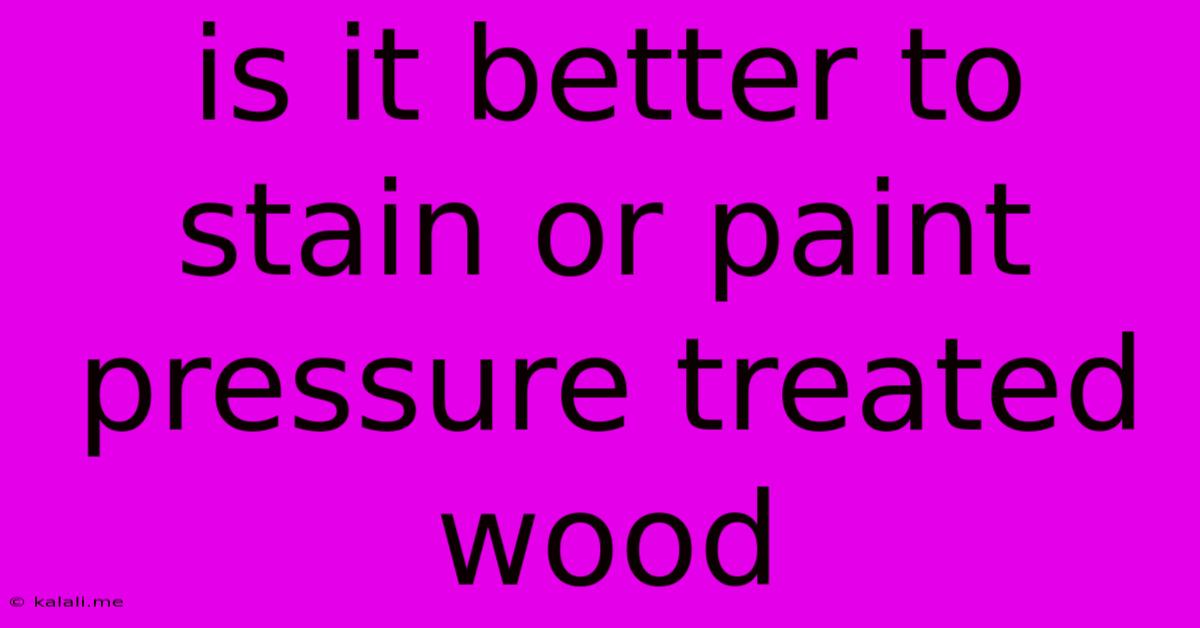Is It Better To Stain Or Paint Pressure Treated Wood
Kalali
Jun 11, 2025 · 3 min read

Table of Contents
Stain vs. Paint for Pressure Treated Wood: Which is Better?
Choosing between staining and painting pressure-treated wood is a crucial decision that impacts both the aesthetics and longevity of your project. Both options offer protection against the elements, but they achieve this in different ways and have distinct advantages and disadvantages. This article will delve into the pros and cons of each, helping you decide which finish is best suited for your needs. Ultimately, the best choice depends on your priorities – aesthetics, budget, and the level of protection required.
Pressure-treated lumber, often used for decks, fences, and other outdoor structures, requires a protective finish to maximize its lifespan and maintain its appearance. While both paint and stain offer protection, they differ significantly in their properties and application.
Understanding Pressure Treated Wood
Before diving into the staining vs. painting debate, it's important to understand the nature of pressure-treated lumber. This wood is treated with preservatives, typically chemicals like copper azole, to protect it from rot, insects, and fungal decay. However, this treatment can affect the wood's ability to absorb certain finishes. This is a key factor influencing the choice between stain and paint.
Staining Pressure Treated Wood: Natural Beauty with Protection
Pros:
- Enhances Natural Grain: Stain penetrates the wood, allowing the natural grain and texture to show through, resulting in a more natural and aesthetically pleasing look. This is especially appealing for projects where the wood's beauty is a key feature.
- Allows Wood to Breathe: Unlike paint, stain allows the wood to "breathe," reducing the risk of moisture buildup and potential damage. This is particularly important in climates with significant temperature fluctuations.
- Easier to Repair: Touching up stained wood is generally easier than repainting. Small areas can be repaired without making the entire surface noticeable.
- Typically Less Expensive: Stain is often a more budget-friendly option compared to paint.
Cons:
- Less Protection: Stain offers less protection against UV rays, moisture, and weathering compared to paint. This means it may require more frequent reapplication.
- Requires Proper Preparation: To ensure proper penetration and longevity, proper surface preparation is crucial. This includes cleaning and sanding the wood to create a smooth surface.
- May Not Be Suitable for All Climates: In harsh climates with extreme temperature fluctuations or high humidity, stain may not provide sufficient protection.
Painting Pressure Treated Wood: Durable Protection with Vibrant Color
Pros:
- Superior Protection: Paint forms a protective barrier, offering superior protection against UV rays, moisture, and weathering compared to stain. This translates to a longer lifespan for your wood project.
- Wide Range of Colors: Paint is available in a wide range of colors, providing more flexibility in terms of aesthetics.
- Conceals Imperfections: Paint effectively hides imperfections in the wood, such as knots or discoloration.
Cons:
- Hides Natural Grain: Paint completely covers the wood's natural grain and texture.
- More Difficult to Repair: Repairing chipped or peeling paint is more challenging and often requires more extensive work.
- Can Trap Moisture: If not applied properly, paint can trap moisture, leading to rot and other damage. Proper surface preparation is crucial here as well.
- Typically More Expensive: Paint tends to be more expensive than stain, both in terms of the product itself and the labor required for application.
Making the Right Choice
The best choice between staining and painting pressure-treated wood depends on your specific needs and priorities. Consider these factors:
- Your Budget: Stain is generally less expensive than paint.
- Desired Aesthetic: Do you want to showcase the wood's natural beauty or prefer a solid, vibrant color?
- Climate: In harsher climates, paint offers superior protection.
- Maintenance: Stain requires more frequent reapplication.
Ultimately, careful consideration of these factors will help you make an informed decision that ensures both the beauty and longevity of your pressure-treated wood project. Remember to always follow the manufacturer's instructions for proper surface preparation and application of your chosen finish.
Latest Posts
Latest Posts
-
Words That Have Oi In It
Jun 12, 2025
-
What Are All The Factors Of 91
Jun 12, 2025
-
Step By Step Laplace Transform Calculator
Jun 12, 2025
-
Which Of The Following Is Not A Lymphoid Organ
Jun 12, 2025
-
How Long Does The Sat Test Last
Jun 12, 2025
Related Post
Thank you for visiting our website which covers about Is It Better To Stain Or Paint Pressure Treated Wood . We hope the information provided has been useful to you. Feel free to contact us if you have any questions or need further assistance. See you next time and don't miss to bookmark.